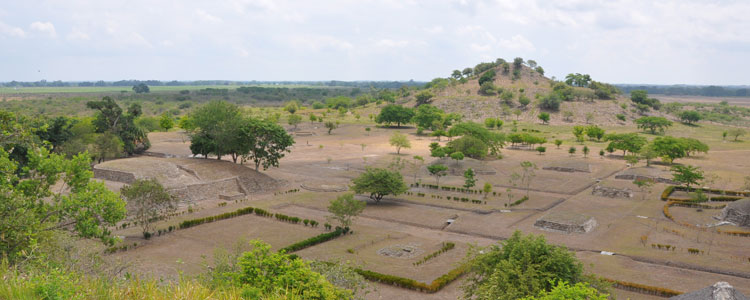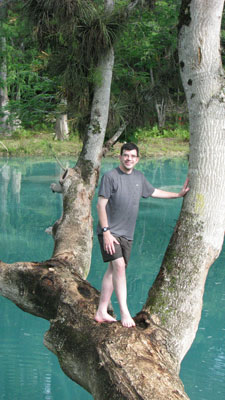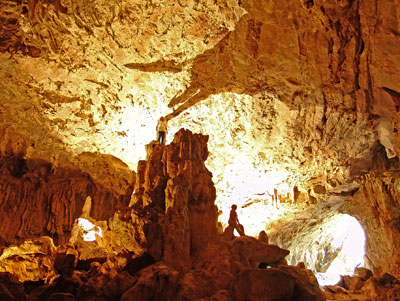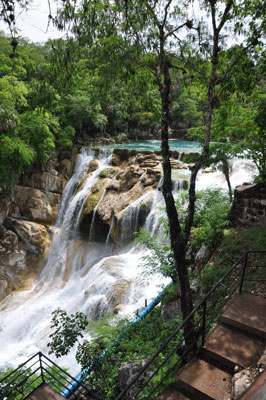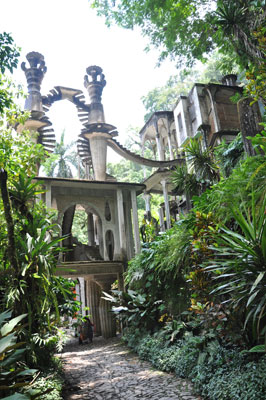Discovering Mexico’s San Luis Potosí
by Cesar Beltran, Contributing Author
I traveled to the state of San Luis Potosí in central Mexico in mid-June ’09 for a tour billed as a mix of nature, culture and adventure. In 1984 I had traveled independently through the southern part of the state, so I was looking forward to seeing how the area had changed and to making new discoveries.
Getting there
Our group of 25 people, from both the US and Mexico, was interested in Mexican culture, and we were able to choose the level of adventure we wished to experience during the trip. The US members of the group arrived by both bus and air at the colonial city of San Luis Potosí, the state’s capital.
Due to a missed connection at the airport in Dallas, I arrived one day late, missing the tour of the city. The next time I visit, I would like to see the city’s Festival of Lights, a colorful and artistic audiovisual display projected onto various historic buildings at night on weekends and holidays. (For additional information on the city, visit www.visitasanluispotosi.com.)
Media Luna Lagoon
After being met by a guide at the airport, we continued by car about two hours east to meet my group at Media Luna, a thermal freshwater lagoon and park near Río Verde.
The next day we walked to the lagoon on a wide boardwalk. Along the way, I was impressed by the clean campsites set among cedar trees. The dock had a ladder, providing access to the water for swimmers, and there was a floating platform in the middle of the lagoon. Park activities include swimming, snorkeling and scuba diving.
Campgrounds are available as well as cabins and dining facilities. While the campground and cabins were full during our stay, there was enough open space to avoid feeling crowded.
Recreation packages, including lodging, can be booked through the scuba diving shop near the park entrance, Buceo Media Luna (phone +52 [487] 872 0854, www.buceomedialuna.com). For instance, a two-day “Discover Diving” package, including a two-night hotel stay with breakfast, park entrance fees, a diving instructor and transportation to and from the dive site, costs $210 per person.
Some members of our group stayed at Hotel Media Luna (phone +52 [487] 872 1473 or e-mail informacion@medialunabuceo.com).
Cave exploration
From Media Luna our bus took us to the remote caverns of Gruta de la Catedral (Cave of the Cathedral) and Gruta del Angel (Cave of the Angel). After an hour on relatively rough roads, our bus started the climb up a narrow canyon road toward the caverns.
On the last leg of the trip our bus got stuck when a wheel slipped off the edge of the road. We were safe but did not need to be told to quickly evacuate the bus!
Most of us then took off on foot up the wooded river canyon for an enjoyable, but unexpected, five-mile hike up to the caverns. The guides used their van and an ATV four-wheeler to shuttle those in the group who did not want to take the long hike.
I carried extra food and water with me throughout the trip, and the extra supplies came in handy on the walk.
We finally arrived at the Cave of the Cathedral’s big main entrance, located on the side of a hill. Once I was inside, I was impressed by the large cavern’s “cathedral” size and quickly realized that it would take some time to explore.
We descended into the cavern on a boarded walkway with handrails. Our guides provided flashlights, but I had also brought my own.
Once I was fully in the cavern I looked up and saw, high above me, a small natural opening that allowed sunlight in. Rappelling into the cavern down through this hole is sometimes offered by the guides.
Stalactites and stalagmites at the back of the cave form an apparent “cathedral” altar and, beyond that, you can crawl through a narrow opening to reach the second cavern, The Angel. Because our bus got stuck on the way up, we didn’t have quite enough time to crawl through to The Angel. I suggest at least two hours to explore both caverns, including time for rests and photos.
In some spots we left the walkway, occasionally needing to help each other with a hand or a rope. There was also a suspended footbridge over the canyon providing a good view of the area.
The bus ride, the hike and touring the caverns completely satisfied my desire for adventure that day.
Our English-speaking guides were from Ecorio Expediciones (phone +52 [487] 872 8815, www.ecorioexpediciones.com [Spanish only]). Guided tours cost around $32 per person, including round-trip transportation from Media Luna, guides, entrance fee, box lunch and safety equipment.
Ciudad Valles
From Media Luna we headed farther east to Cuidad Valles, centered in the state’s Huasteca region. The road to Valles is notoriously curvy, so I took some Dramamine, relaxed with a movie and was glad I was not driving the bus.
We stayed at Hotel Valles (phone +52 [481] 382 0050, www.hotelvalles.com), a 10-acre, colonial-style property with lush gardens. Valles was our base for the remainder of the trip and I enjoyed my spacious room there for those two nights.
Tamtoc archaeological site
From Valles we were driven east through fields of sugarcane and other crops growing on a river plain to the Tamtoc archaeological site, near Tamuín. Our tour began at the visitors’ center, and we walked much of the 329-acre site on a hot and humid day.
The archaeologist accompanying us explained that Tamtoc was an important religious and political center for the Huastec people between 300 BC and AD 300. One stop along the way included a partially excavated pyramid, 128 feet high. It looked, to me, like a large hill until I noticed the pebble-covered foundation and a wide, stepped path leading to the top.
We stopped on top of another pyramid mound to view the entire city site, which is only about 25% excavated. Many raised building foundations were visible, and I could easily picture how wide, flat streets and plazas connected the buildings.
This is a very low-key tourist destination, but it was a memorable educational opportunity for me. If you do plan to visit, I suggest that you read up on the site and maybe even bring your own notes. Not all guides at the site speak English, and our translator had difficulty with the advanced archaeological and cultural vocabulary. I did not see any information in English available for purchase at the visitors’ center.
Tours can be arranged through the Hotel Valles or with any of the number of agents listed on the San Luis Potosí website.
Salto del Meco
A highlight of my trip was seeing the rushing blue-green Salto del Meco waterfall, over 100 feet high, and swimming in a calm section of the river downstream.
Salto del Meco is located about 50 miles to the north of Valles in a mountain range with a river canyon. The steps to the waterfall overlook were wet with spray, and as I walked, small butterflies — in yellow, brown, orange, black and white — fluttered just above my feet and up into the trees.
The overlook and the swimming spot can be accessed through a small ecoresort managed by the company Huasteca Secreta (phone +52 [481] 381 4011, www.huastecasecreta.com). The resort’s outstanding restaurant offered us a break from the heat and from the heavier, spicy food that we had been eating throughout our trip.
I passed on the first course (fish broth), but I enjoyed red snapper and fettuccini, unusual but delicious creamy mashed potatoes flavored with pineapple juice, and an outstanding flan.
The small resort complex was newly opened and had a large pool with a bar. Five of its 10 rooms were done in an ecoresort style, with open-air showers and windows without glass.
Reservations are required for both the restaurant and resort. Rooms start at $220 per night. Huasteca Secreta can arrange your transportation to and from Valles.
El Sótano de las Golondrinas
The next day we set off before dawn to the awe-inspiring Sótano de las Golondrinas (Cave of Swallows) near Aquismón. The location is managed through a partnership between the government and the indigenous people of the area, who provided our guides (a man and his young son).
The trail down the forested canyon was often wet and slippery, so I was glad that I accepted the walking stick offered at the start of trail. It was fascinating to see coffee plants with their green beans growing in the shade. There were mild-flavored ground coffee beans for sale on the trail.
The Cave of Swallows is a huge sinkhole. It wasn’t visible when we first started the walk, but we got glimpses of it in clearings and bends along the trail. When we reached the edge, the guide tied a thick rope around my waist, tying the other end securely to a tree, and had me lean over the huge cave opening to get my first, full, knee-wobbling, breathtaking view.
We arrived in time for sunrise, watching as the light penetrated the massive, 1,200-foot-deep pit and signaled the flocks of green parrots and swallows that live in the canyon walls to depart. Squawking and calling out to each other, they flew in slow circles up the edges of the cave, continuing up and out into the surrounding forest.
We spent a long time on an observation platform and the surrounding rocks watching the birds and marveling at the size and beauty of the cave.
Edward James Gardens
Next we traveled farther south to visit the magical Edward James Gardens, located just outside the city of Xilitla. A patron of surreal art in Europe, Edward James sponsored his own artistic project on 80 acres of mountainous tropical forest, adjacent to a 230-foot-high waterfall. He hired artisans to realize his surreal concepts in the construction of his stone-and-concrete home and the surrounding gardens.
As our guide led us on a walk through the entire site and to the waterfall, I was stunned by the scale of the art and architecture. The concrete structures didn’t even try for accuracy or functionality. We had to figure out what we were seeing and we didn’t know what to expect next. Where I saw a large, fantastical blue airliner, others saw a submarine.
Floral and tree designs were repeated in the garden either as sculpture or incorporated into columns or walls. There were high, winding staircases and walkways leading to nowhere. I climbed most of them, but fear did rule out my climbing the largest staircase without handrails.
The garden structures blended in with the surrounding forest and, overall, resembled an ancient ruin.
At the end of the tour I was pleasantly surprised to find a good gift shop, where I picked up a booklet written in both Spanish and English. It was rare to find bilingual tourist information on this trip.
Our guide, Carlos Barboza, captured my attention throughout the tour with his insights. For information on guided tours, phone +52 [489] 100 5804.
From the Edward James house we took a short drive to the town center, where it was market day (Sunday). Goods for sale spilled out of every shop.
At the large town square, a good, regional guitar group played from the large stage as we were led into the plaza to watch, or participate in, the dancing that was going on there.
H1N1 virus concerns
Prior to departure, I did have a concern about the H1N1 virus, also known as “swine flu.” I checked with both the Centers for Disease Control & Prevention (www.cdc.gov) and my health plan’s travel nurse and received the “all clear” from both sources, as I was healthy, plus reported incidents of the flu were low.
At the San Luis Potosí International Airport, all arriving passengers were required to answer a short medical questionnaire which included all of the symptoms of H1N1. We handed the card to a health worker, who glanced us over and took our temperatures by infrared thermometer.
Check the CDC website and talk to your doctor for current recommendations.
Observations
None of the locations on this trip felt commercialized or overrun by tourists. Although visitors to the state have long been primarily Mexican vacationers, the area is becoming better known to US and foreign travelers. The tourism industry is expanding to keep pace, but English translations were limited or not available, and I had to use my limited Spanish every day. Guides are recommended for non-Spanish speakers.
Websites listed in this article have limited English content, but e-mails in English should receive replies.
If planning a visit to San Luis Potosí, keep your schedule flexible; I found that my group often experienced start delays.
Keep in mind that park bathrooms may not have toilet paper or soap. I almost always wore a waist pack stocked with a nutrition bar, water, toilet paper and hand sanitizer/wipes, and I kept a day pack on the bus with additional supplies and clothing.
Note that some hotels only have fans, and the most commonly used type of air-conditioning is referred to as a “split,” a combination evaporative cooler and heater, some without thermostats.
I felt well cared for by the guides and the staff at various locales, but I also packed as if I would be “roughing it” at times. Strangers were helpful in a pinch.
Cesar Beltran was a guest of the Mexico and San Luis Potosí tourism boards (phone 011 52 444 812 9939, www.visitasanluispotosi.com).

